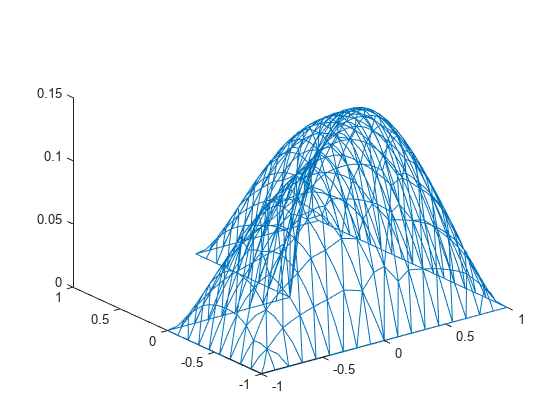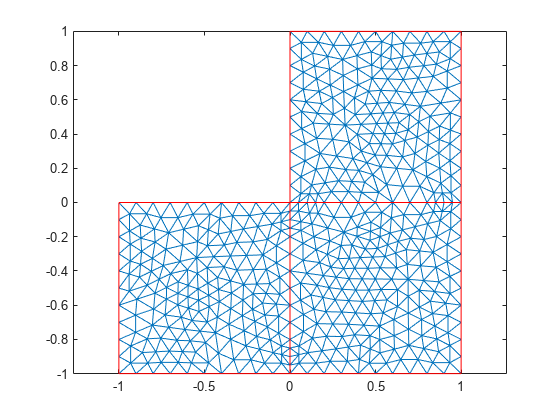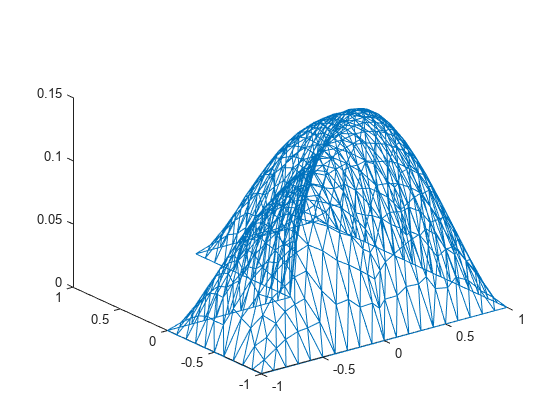pdemesh
Plot PDE mesh
Syntax
Description
pdemesh( plots the mesh
represented by the fegeometry)Mesh property of an
fegeometry object.
pdemesh(___,
plots the mesh or solution data using any of the arguments in the previous
syntaxes and one or more Name,Value)Name,Value pair arguments.
h = pdemesh(___)
Examples
Mesh Plot for L-Shaped Membrane
Create a mesh plot and display the node and element labels of the mesh.
Create a PDE model. Include the geometry of the built-in function lshapeg. Mesh the geometry.
model = createpde; geometryFromEdges(model,@lshapeg); mesh = generateMesh(model);
Plot the mesh.
pdemesh(model)

Alternatively, you can plot a mesh by using mesh as an input argument.
pdemesh(mesh)

Another approach is to use the nodes and elements of the mesh as input arguments for pdemesh.
pdemesh(mesh.Nodes,mesh.Elements)

Display node labels.
pdemesh(model,NodeLabels="on")
Use xlim and ylim to zoom in on particular nodes.
xlim([-0.4,0.4]) ylim([-0.4,0.4])

Display element labels.
pdemesh(model,ElementLabels="on")
xlim([-0.4,0.4])
ylim([-0.4,0.4])
Apply boundary conditions, specify coefficients, and solve the PDE.
applyBoundaryCondition(model,"dirichlet", ... Edge=1:model.Geometry.NumEdges, ... u=0); specifyCoefficients(model,m=0,... d=0,... c=1,... a=0,... f=1); generateMesh(model); results = solvepde(model)
results =
StationaryResults with properties:
NodalSolution: [1141x1 double]
XGradients: [1141x1 double]
YGradients: [1141x1 double]
ZGradients: []
Mesh: [1x1 FEMesh]
u = results.NodalSolution;
Plot the solution at nodal locations by using pdemesh.
pdemesh(model,u)

The pdemesh function ignores NodeLabels and ElementLabels when you plot solution data as a 3-D plot.
Transparency for 3-D Mesh
Create a PDE model, include the geometry and mesh it.
model = createpde;
importGeometry(model,"Plate10x10x1.stl");
generateMesh(model,Hmax=5);Plot the mesh setting the transparency to 0.5.
pdemesh(model,FaceAlpha=0.5)

Elements Associated with Particular Face
Find the elements associated with a geometric region.
Create a PDE model.
model = createpde;
Include the geometry of the built-in function lshapeg. Plot the geometry.
geometryFromEdges(model,@lshapeg); pdegplot(model,FaceLabels="on",EdgeLabels="on")

Generate a mesh.
mesh = generateMesh(model,Hmax=0.5);
Find the elements associated with face 2.
Ef2 = findElements(mesh,"region",Face=2);Highlight these elements in green on the mesh plot.
figure pdemesh(mesh,ElementLabels="on") hold on pdemesh(mesh.Nodes,mesh.Elements(:,Ef2),EdgeColor="green")

[p,e,t] Mesh Plot
Plot the mesh for the geometry of the L-shaped membrane.
[p,e,t] = initmesh("lshapeg"); [p,e,t] = refinemesh("lshapeg",p,e,t); pdemesh(p,e,t)

Now solve Poisson's equation over the geometry defined by the L-shaped membrane. Use Dirichlet boundary conditions on , and plot the result.
u = assempde("lshapeb",p,e,t,1,0,1);
pdemesh(p,e,t,u)
Input Arguments
model — Model container
femodel object | PDEModel object | ThermalModel object | StructuralModel object | ElectromagneticModel object
Model container, specified as an femodel object,
PDEModel object, ThermalModel
object, StructuralModel object, or
ElectromagneticModel object.
u — PDE solution
vector | matrix
PDE solution, specified as a vector or matrix.
Example: results = solvepde(model); u =
results.NodalSolution; or u =
assempde(model,c,a,f);
fegeometry — Geometry object for finite element analysis
fegeometry object
Geometry object for finite element analysis, specified as an fegeometry object. The pdemesh function
plots the mesh from the Mesh property of the fegeometry object.
mesh — Mesh description
FEMesh object
Mesh description, specified as an FEMesh
object. See FEMesh Properties.
nodes — Nodal coordinates
2-by-NumNodes matrix | 3-by-NumNodes matrix
Nodal coordinates, specified as a 2-by-NumNodes matrix for a 2-D mesh and 3-by-NumNodes matrix for a 3-D mesh. NumNodes is the number of nodes.
elements — Element connectivity matrix in terms of node IDs
NodesPerElem-by-NumElements
matrix
Element connectivity matrix in terms of node IDs, specified as an NodesPerElem-by-NumElements matrix. NodesPerElem is the number of nodes per element. Linear meshes contain only corner nodes, so there are three nodes per a 2-D element and four nodes per a 3-D element. Quadratic meshes contain corner nodes and nodes in the middle of each edge of an element. For quadratic meshes, there are six nodes per a 2-D element and 10 nodes per a 3-D element.


p — Mesh points
matrix
Mesh points, specified as a 2-by-Np matrix of points, where
Np is the number of points in the mesh. For a description of the
(p,e,t) matrices, see Mesh Data as [p,e,t] Triples.
Typically, you use the p, e, and t
data exported from the PDE Modeler app, or generated by initmesh or refinemesh.
Example: [p,e,t] = initmesh(gd)
Data Types: double
e — Mesh edges
matrix
Mesh edges, specified as a 7-by-Ne matrix of edges,
where Ne is the number of edges in the mesh. For a description of the
(p,e,t) matrices, see Mesh Data as [p,e,t] Triples.
Typically, you use the p, e, and t
data exported from the PDE Modeler app, or generated by initmesh or refinemesh.
Example: [p,e,t] = initmesh(gd)
Data Types: double
t — Mesh triangles
matrix
Mesh triangles, specified as a 4-by-Nt matrix of
triangles, where Nt is the number of triangles in the mesh. For a
description of the (p,e,t)
matrices, see Mesh Data as [p,e,t] Triples.
Typically, you use the p, e, and t
data exported from the PDE Modeler app, or generated by initmesh or refinemesh.
Example: [p,e,t] = initmesh(gd)
Data Types: double
Name-Value Arguments
Specify optional pairs of arguments as
Name1=Value1,...,NameN=ValueN, where Name is
the argument name and Value is the corresponding value.
Name-value arguments must appear after other arguments, but the order of the
pairs does not matter.
Before R2021a, use commas to separate each name and value, and enclose
Name in quotes.
Example: pdemesh(model,NodeLabels="on")
NodeLabels — Node labels
"off" (default) | "on"
Node labels, specified as "off" or
"on".
pdemesh ignores NodeLabels
when you plot solution data as a 3-D plot.
Example: NodeLabels="on"
Data Types: char | string
ElementLabels — Element labels
"off" (default) | "on"
Element labels, specified as "off" or
"on".
pdemesh ignores ElementLabels
when you plot solution data as a 3-D plot.
Example: ElementLabels="on"
Data Types: char | string
FaceAlpha — Surface transparency for 3-D geometry
1 (default) | real number from 0 through 1
Surface transparency for 3-D geometry, specified as a real number from 0
through 1. The default value 1 indicates no
transparency. The value 0 indicates complete transparency.
Example: FaceAlpha=0.5
Data Types: double
EdgeColor — Color of mesh edges
short color name | long color name | RGB triplet
Color of mesh edges, specified as a short or long color name or an RGB
triplet. By default, for 2-D meshes the edges within one face are blue
(RGB triplet [0 0 1]) and the edges between faces are
red (RGB triplet [1 0 0]). For 3-D meshes, the
default edge color is black (RGB triplet [0 0
0]).
The short names and long names are character vectors that specify one of eight predefined colors. The RGB triplet is a three-element row vector whose elements specify the intensities of the red, green, and blue components of the color; the intensities must be in the range [0 1]. The following table lists the predefined colors and their RGB triplet equivalents.
RGB Triplet | Short Name | Long Name |
|---|---|---|
|
|
|
|
|
|
|
|
|
|
|
|
|
|
|
|
|
|
|
|
|
|
|
|
Example: EdgeColor="green"
Data Types: double | char | string
FaceColor — Color of mesh faces for 3-D meshes
[0 1 1] | short color name | long color name | RGB triplet
Color of mesh faces for 3-D meshes, specified as a short or long color
name or an RGB triplet. The default face color is cyan (RGB triplet
[0 1 1]). For details about available colors, see
EdgeColor.
Example: FaceColor="green"
Data Types: double | char | string
Output Arguments
h — Handles to graphics objects
vector
Handles to graphics objects, returned as a vector.
Version History
Introduced before R2006aR2023a: Finite element model
pdemesh accepts femodel and
fegeometry
objects as input arguments.
R2020a: Improved performance for plots with many text labels
pdemesh shows faster rendering and better responsiveness for
plots that display many text labels. Code containing
findobj(fig,'Type','Text') no longer returns labels on
figures produced by pdemesh.
R2018a: Highlighting particular nodes and elements on mesh plots
pdemesh accepts node and element IDs as input arguments,
letting you highlight particular nodes and elements on mesh plots.
R2016b: Transparency, node and element labels
You can now set plot transparency by using FaceAlpha, and
display node and element labels by using NodeLabels and
ElementLabels, respectively.
Comando de MATLAB
Ha hecho clic en un enlace que corresponde a este comando de MATLAB:
Ejecute el comando introduciéndolo en la ventana de comandos de MATLAB. Los navegadores web no admiten comandos de MATLAB.

Select a Web Site
Choose a web site to get translated content where available and see local events and offers. Based on your location, we recommend that you select: .
You can also select a web site from the following list:
How to Get Best Site Performance
Select the China site (in Chinese or English) for best site performance. Other MathWorks country sites are not optimized for visits from your location.
Americas
- América Latina (Español)
- Canada (English)
- United States (English)
Europe
- Belgium (English)
- Denmark (English)
- Deutschland (Deutsch)
- España (Español)
- Finland (English)
- France (Français)
- Ireland (English)
- Italia (Italiano)
- Luxembourg (English)
- Netherlands (English)
- Norway (English)
- Österreich (Deutsch)
- Portugal (English)
- Sweden (English)
- Switzerland
- United Kingdom (English)